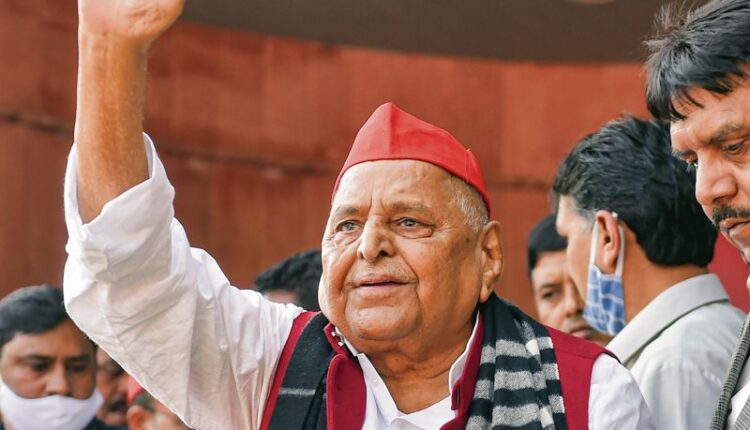
The doyen of UP politics
This story first appeared in The Tribune
Despite reverses, Mulayam managed to stay at the top of the game for over 50 yrs
The passing away of Mulayam Singh Yadav marks the end of an era in UP, where his friends, party folk and voters affectionately called him ‘Netaji’. It is inconceivable to think of UP politics without him. He reigned supreme — despite the reverses that the heartland’s tumultuous politics invariably brings — for over 50 years until illness grounded him. He was elected a legislator 10 times from various socialist formations, as a Lok Sabha MP seven times, was thrice the UP chief minister and once the country’s defence minister in the United Front regime, which was regarded as his career’s capstone.
However impressive a CV he possessed, Mulayam’s legacy cannot be measured against the positions bestowed on him by his diligence, artfulness and resilience. The ideological moorings which set him apart from most non-BJP politicians during a particular phase of UP’s political history became shaky once his survival instincts overtook. But the legacy he bequeaths as the leader of the Samajwadi Party, which he founded on October 4, 1992, to shake off the amoeba-like socialist organisms that disappeared as quickly as they appeared, derives its salience from the deep-seated and, now irreversible, changes wrought by a single and singular move piloted by a former PM, VP Singh.
Singh’s own desperation to save his office from internal challenges in the Janata Dal and external pressures brought upon his minority government by his ally, the BJP, might have propelled him to recommend the implementation of the Mandal Commission recommendations. The panel, set up to identify the ‘socially and educationally backward classes’, recommended 27 per cent reservation for the OBCs in government employment, including PSUs. The recommendation and its prospective implementation presaged the arrival of OBC empowerment in North India, a process that the southern states and parts of the west underwent before and after Independence. Reservation in jobs ran parallel with political empowerment for the neglected non-upper castes of North India for the first time.
The biggest and immediate beneficiaries of Singh’s ‘radical’ initiative were Mulayam, Lalu Prasad and Kalyan Singh, and later, a host of others, including this trio’s legatees and BJP leaders, notably Modi. The BJP shrewdly grasped the implications of the Mandal move and embraced the proposal, alongside the propagation of Hindutva-centred politics. It might ascribe Modi’s rise largely to a ‘Hindutva renaissance’ but beneath this phenomenon lay an underpinning of OBC power, which Modi, who comes from a more backward caste of Gujarat, harnessed.
Mulayam had already tasted a shred of OBC power as a cooperatives minister in the Janata Party government in UP, headed by Ram Naresh Yadav. He expanded the cooperatives sector in agriculture and dairy, involved the Yadavs who were big in both areas and tried to undermine the hegemony of the upper castes. It was a small slice of a big pie for the Yadavs, but the bestowal caused desperation in them to grab pieces of the pie. The intra-caste rivalries spilled on the streets of Mulayam’s home turf, Etawah. Mulayam, who was a trained wrestler, was the right person to confront the physical might of his adversaries.
The political paths mapped by Mulayam and Lalu Prasad in Bihar ran parallel but there was a big difference in their approach to handling the challenges posed by a rising BJP and the spread of Hindutva. Some would regard 1990 as the apotheosis of Mulayam’s career because he thwarted the BJP’s effort to lay siege to the Babri mosque by using police force. The events extracted a heavy electoral toll on him. Indeed, in the elections that followed the eventual Babri demolition in 1992 (under a BJP dispensation), Mulayam was forced to join hands with the BSP and forge an OBC-Dalit-Muslim alliance to answer the BJP. The SP-BSP won the 1993 election by a whisker but Mulayam could not ignore the contradictions inherent in the caste combination. The upwardly mobile Yadavs refused to countenance the rise of the Dalits and their conflicts resulted in rural violence.
UP’s highly stratified caste hierarchy, with the upper castes still ruling at the apex, afforded little leeway for inter-caste mobility, let alone integration. Even in his heyday, Mulayam’s socialist friends were largely the ‘savarnas’ but not Dalits. Probably, he inherited the antipathy towards Dalits from his caste history. Lalu Prasad, on the other hand, cemented a coalition of the OBCs, including the more and extremely backward castes, and Dalits with greater ease and was, therefore, more successful in Bihar than Mulayam until he was enveloped in graft charges.
In his later years, realpolitik and survival were paramount for Mulayam. The BJP was the principal pole and he made peace with the party which enabled the installation of an SP government in Lucknow in 2003 during the Vajpayee regime. He reciprocated the BJP’s help by allowing its Speaker Kesri Nath Tripathi to continue for over a year until Tripathi’s term ended.
By now, Mulayam’s close association with Amar Singh — a gadfly who became his political confidant — opened the gateway to Bollywood and Mumbai’s corporate sector and diluted his political origin. A leader who kept company with socialist greats, like Janeshwar Mishra and Kapildeo Singh, was comfortable with Amitabh Bachchan and Anil Ambani.
In his autumn years, he was forced to cope with the bane of dynastic politics. The ascendancy of his son Akhilesh triggered a bitter family feud which ended in the SP’s split. By then, much of its OBC base was eaten away by the BJP. Politics came full circle for Mulayam. But who knows when the hands of the clock might move again in the right direction for the SP?
